Overview
The story takes place on February 14 with the harlequin giving Missy his heart, literally, by nailing it to her door. The story follows the unflappable Missy as she tries to discover who gave her this gift, and what she does with it. The merry harlequin follows her the whole time, wondering what this Columbina , as he calls his various loves he has given his heart to, will do with it. True to his classic trickster ways, in the same vein as Puck, he's constantly meddling with other people's lives and causing mischief as he goes, which often get blamed on Pierrot. The story concludes with Missy eating the raw heart (with a side of hash browns and ketchup) at a diner; she is transformed into a new harlequin, while the old harlequin is transformed into a kitchen helper named Pete, who has no memories of ever being the harlequin.
The story includes many of the classic characters from the Harlequinade in modern forms. Most obviously is Harlequin and his sought-after love Columbina, who is named Missy in this modern version. Pantaloon, the third person in the love triangle, also exists here in full.
The artwork is a mixture of digitally enhanced photographs overlaid with painting. This serves the story very well as the fantastic Harlequin follows and interacts with the sensible Missy in her normal world. The backgrounds are made very drab, compared to the colorful characters which almost vibrate on top of them.
At the back of the book is Gaiman's essay, "Notes on a Harlequinade", which tells us a little about the old harlequin stories of the Italian Commedia dell'arte and the English Harlequinade.

A clown is a person who performs physical comedy and arts in an open-ended fashion, typically while wearing distinct makeup or costuming and reversing folkway-norms. The art of performing as a clown is known as clowning or buffoonery, and the term "clown" may be used synonymously with predecessors like jester, joker, buffoon, fool, or harlequin. Clowns have a diverse tradition with significant variations in costume and performance. The most recognisable clowns are those that commonly perform in the circus, characterized by colorful wigs, red noses, and oversized shoes. However, clowns have also played roles in theater and folklore, like the court jesters of the Middle Ages and the jesters and ritual clowns of various indigenous cultures. Their performances can elicit a range of emotions, from humor and laughter to fear and discomfort, reflecting complex societal and psychological dimensions. Through the centuries, clowns have continued to play significant roles in society, evolving alongside changing cultural norms and artistic expressions.
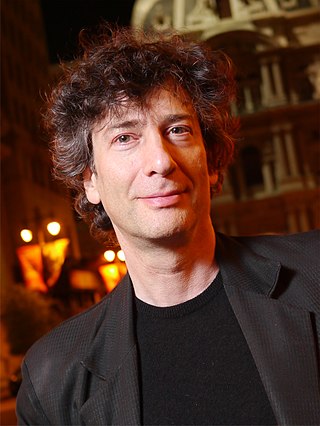
Neil Richard MacKinnon Gaiman is an English author of short fiction, novels, comic books, graphic novels, audio theatre, and screenplays. His works include the comic book series The Sandman and the novels Good Omens, Stardust, Anansi Boys, American Gods, Coraline, and The Graveyard Book. He co-created the TV series adaptations of Good Omens and The Sandman.

Harlequin is the best-known of the comic servant characters (Zanni) from the Italian commedia dell'arte, associated with the city of Bergamo. The role is traditionally believed to have been introduced by the Italian actor-manager Zan Ganassa in the late 16th century, was definitively popularized by the Italian actor Tristano Martinelli in Paris in 1584–1585, and became a stock character after Martinelli's death in 1630.
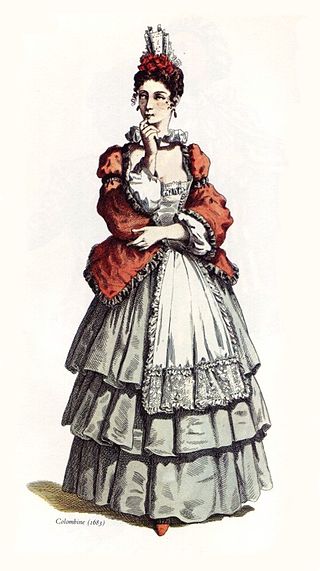
Columbine is a stock character in the commedia dell'arte. She is Harlequin's mistress, a comic servant playing the tricky slave type, and wife of Pierrot. Rudlin and Crick use the Italian spelling Colombina in Commedia dell'Arte: A Handbook for Troupes.

Pantalone, spelled Pantaloon in English, is one of the most important principal characters found in commedia dell'arte. With his exceptional greed and status at the top of the social order, Pantalone is "money" in the commedia world. His full name, including family name, is Pantalon de' Bisognosi, Italian for 'Pantalone of the Needy'.

Pierrot, a stock character of pantomime and commedia dell'arte, has his origins in the late 17th-century Italian troupe of players performing in Paris and known as the Comédie-Italienne. The name is a diminutive of Pierre (Peter), using the suffix -ot and derives from the Italian Pedrolino. His character in contemporary popular culture—in poetry, fiction, and the visual arts, as well as works for the stage, screen, and concert hall—is that of the sad clown, often pining for love of Columbine. Performing unmasked, with a whitened face, he wears a loose white blouse with large buttons and wide white pantaloons. Sometimes he appears with a frilled collaret and a hat, usually with a close-fitting crown and wide round brim and, more rarely, with a conical shape like a dunce's cap.

Il Capitano is one of the four stock characters of commedia dell'arte. He most probably was never a "Captain", but rather appropriated the name for himself.
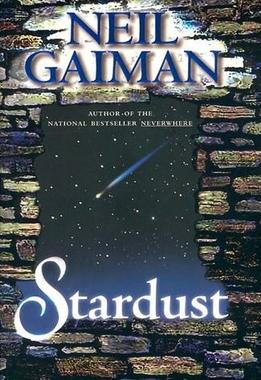
Stardust is a 1999 fantasy novel by British writer Neil Gaiman, usually published with illustrations by Charles Vess. Stardust has a different tone and style from most of Gaiman's prose fiction, being consciously written in the tradition of pre-Tolkien English fantasy, following in the footsteps of authors such as Lord Dunsany and Hope Mirrlees. It is concerned with the adventures of a young man from the village of Wall, which borders the magical land of Faerie.

Harlequinade is an English comic theatrical genre, defined by the Oxford English Dictionary as "that part of a pantomime in which the harlequin and clown play the principal parts". It developed in England between the 17th and mid-19th centuries. It was originally a slapstick adaptation or variant of the commedia dell'arte, which originated in Italy and reached its apogee there in the 16th and 17th centuries. The story of the Harlequinade revolves around a comic incident in the lives of its five main characters: Harlequin, who loves Columbine; Columbine's greedy and foolish father Pantaloon, who tries to separate the lovers in league with the mischievous Clown; and the servant, Pierrot, usually involving chaotic chase scenes with a bumbling policeman.
Il Dottore, most commonly known in Italian as Dottor Balan or simply Balanzone, is a commedia dell'arte stock character, in one scenario being an obstacle to young lovers. Il Dottore and Pantalone are the comic foils of each other, Pantalone being the decadent wealthy merchant, and il Dottore being the decadent erudite. He has been part of the main canon of characters since the mid-16th century.
"Snow, Glass, Apples" is a 1994 short story written by Neil Gaiman. It was originally released as a benefit book for the Comic Book Legal Defense Fund and was reprinted in the anthology Love in Vein II, edited by Poppy Z. Brite. It is a retelling of the Brothers Grimm fairy tale Snow White, but from her stepmother's point of view.
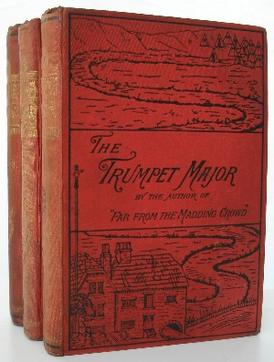
The Trumpet-Major is a novel by Thomas Hardy published in 1880, and his only historical novel. Hardy included it with his "romances and fantasies". It concerns the heroine, Anne Garland, being pursued by three suitors: John Loveday, the eponymous trumpet major in a British regiment, honest and loyal; his brother Bob, a flighty sailor; and Festus Derriman, the cowardly nephew of the local squire. Unusually for a Hardy novel, the ending is not entirely tragic; however, there remains an ominous element in the probable fate of one of the main characters.

Pantomime is a type of musical comedy stage production designed for family entertainment. It was developed in England and is performed throughout the United Kingdom, Ireland and in other English-speaking countries, especially during the Christmas and New Year season. Modern pantomime includes songs, gags, slapstick comedy and dancing. It generally combines gender-crossing actors and topical humour with a story more or less based on a well-known fairy tale, fable or folk tale. Pantomime is a participatory form of theatre, in which the audience is encouraged and expected to sing along with certain parts of the music and shout out phrases to the performers.
John Bolton is a British comic book artist and illustrator most known for his dense, painted style, which often verges on photorealism. He was one of the first British artists to come to work in the American comics industry, a phenomenon which took root in the late 1980s and has since become standard practice.

The Servant of Two Masters is a comedy by the Italian playwright Carlo Goldoni written in 1746. Goldoni originally wrote the play at the request of actor Antonio Sacco, one of the great Harlequins in history. His earliest drafts had large sections that were reserved for improvisation, but he revised it in 1789 in the version that exists today. The play draws on the tradition of the earlier Italian commedia dell'arte.

Carnaval is a ballet based on the music of Robert Schumann's piano suite Carnaval, Op. 9, as orchestrated by Alexander Glazunov, Nikolai Rimsky-Korsakov, Anatoly Lyadov and Alexander Tcherepnin. It was choreographed by Michel Fokine to his own libretto, with costumes designed by Léon Bakst, and premiered in Pavlovsk on 5 March 1910.
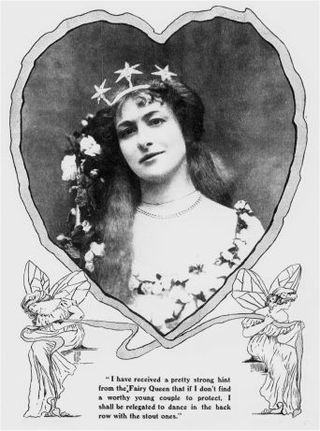
Harlequin and the Fairy's Dilemma, retitled The Fairy's Dilemma shortly after the play opened, is a play in two acts by W. S. Gilbert that parodies the harlequinade that concluded 19th-century pantomimes.
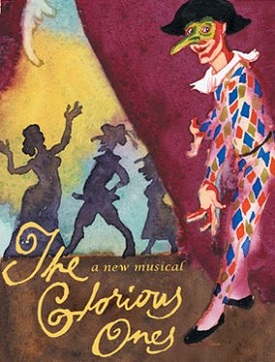
The Glorious Ones is a musical with book and lyrics by Lynn Ahrens and music by Stephen Flaherty. Set in 17th-century Italy, it concerns a theatre group in the world of commedia dell'arte and theatre of the Italian Renaissance.

Commedia dell'arte was an early form of professional theatre, originating from Italian theatre, that was popular throughout Europe between the 16th and 18th centuries. It was formerly called Italian comedy in English and is also known as commedia alla maschera, commedia improvviso, and commedia dell'arte all'improvviso. Characterized by masked "types", commedia was responsible for the rise of actresses such as Isabella Andreini and improvised performances based on sketches or scenarios. A commedia, such as The Tooth Puller, is both scripted and improvised. Characters' entrances and exits are scripted. A special characteristic of commedia is the lazzo, a joke or "something foolish or witty", usually well known to the performers and to some extent a scripted routine. Another characteristic of commedia is pantomime, which is mostly used by the character Arlecchino, now better known as Harlequin.















